Panasonic Lumix DMC-LX3
-
-
Written by Gordon Laing
Panasonic Lumix DMC-LX3 resolution comparison
Panasonic Lumix DMC-LX3 results continued…
| Support this site by shopping via these links | ||||||||||||||||||||||||||||||||||||||||||
 |
To measure and compare the Panasonic Lumix DMC-LX3’s resolving power we photographed the Enhanced Digital Camera Resolution Chart with it and a number of rival compacts, each using their best quality JPEG and default image tone and sharpening settings. Each camera was tested at every aperture setting and the best result selected for this page. The crops are taken from the original images, saved as High Quality JPEGs in Photoshop CS2 and presented here at 100%. Each number represents 100 lines per picture height (lpph), so a figure of 20 means a resolution of 2000 lpph. |
In terms of resolving power, the Panasonic Lumix DMC-LX3 delivers 2250 lpph of horizontal and vertical resolution. This is a good result for a 10.1 Megapixel sensor, and puts it on par with our results from the Canon PowerShot G9 and Sony Cyber-shot DSC-W200, both of which sport 12.1 Megapixel sensors. Panasonic made a conscious decision to not boost the resolution of the LX3’s sensor and instead stay at a level where it should deliver decent low light performance. This Megapixel sacrifice has certainly not had a negative impact on resolved detail here, but to find out how it impacts noise, head onto our Panasonic LX3 High ISO results page. Alternatively, if you’re interested to see whether shooting in RAW can unveil greater detail still, scroll down to the bottom of this page. |
Panasonic Lumix LX3 |
Canon PowerShot G9 | |
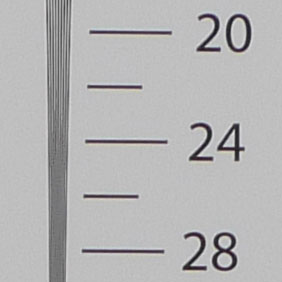 | 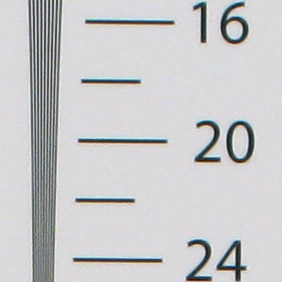 | |
2250 lpph, 5.1-12.8mm at 12.8mm, f2.8, 80 ISO |
2250 lpph, 7.4-44.4mm at 15mm, f4, 80 ISO | |
Canon EOS 450D / XSi with EF-S 18-55mm IS |
Sony Cyber-shot DSC-W200 | |
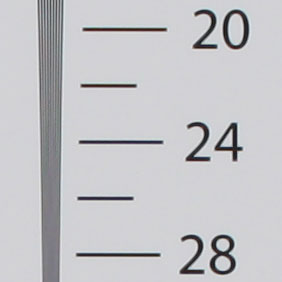 | 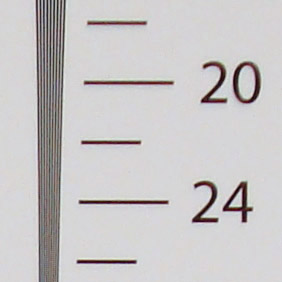 | |
2200 lpph, EF-S 18-55mm IS at 35mm, f8, 100 ISO |
2250 lpph, 7.6-22.8mm at 12mm, f3.5, 100 ISO |
Panasonic Lumix LX3 |
Canon PowerShot G9 | |
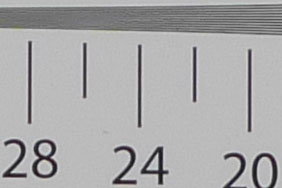 | 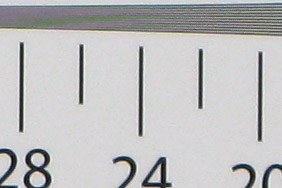 | |
2250 lpph, 5.1-12.8mm at 12.8mm, f2.8, 80 ISO |
2250 lpph, 7.4-44.4mm at 15mm, f4, 80 ISO | |
Canon EOS 450D / XSi with EF-S 18-55mm IS |
Sony Cyber-shot DSC-W200 | |
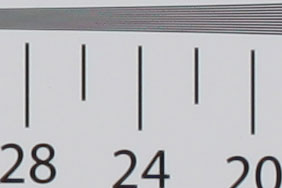 | 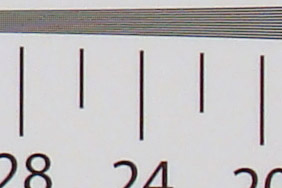 | |
2225 lpph, EF-S 18-55mm IS at 35mm, f8, 100 ISO |
2250 lpph, 7.6-22.8mm at 12mm, f3.5, 100 ISO |
Panasonic Lumix DMC-LX3 Studio resolution: JPEG versus RAW
We photographed our test chart in the Lumix LX3’s RAW plus Fine JPEG mode, allowing us to directly compare images created from exactly the same data. Below are 100% crops taken from the original JPEG file alongside the RAW version, processed using the supplied Silkypix Developer Studio 3.0SE software and its default settings.
The result here is similar to what we saw with a landscape subject on the previous page: more refrained processing on the part of Silkypix’s default settings has delivered an image which looks almost fuzzy in comparison to the in-camera JPEG.
Look closely though and the resolved detail is essentially the same, and most of the punchiness of the in-camera JPEG comes from greater contrast and sharpening. As always, shooting in RAW does give you more chance to tweak the image processing, but in the case of the LX3, it doesn’t look like it will unveil any greater detail.
Now let’s check out the camera’s performance at different sensitivities in our Panasonic Lumix DMC-LX3 noise results page.
Panasonic Lumix LX3: JPEG |
Panasonic Lumix LX3: RAW | |
 | 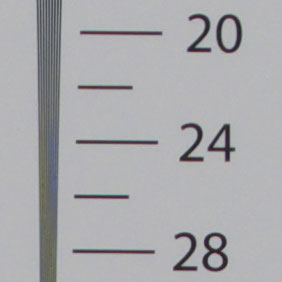 | |
2250 lpph, 5.1-12.8mm at 12.8mm, f2.8, 80 ISO |
2250 lpph, 5.1-12.8mm at 12.8mm, f2.8, 80 ISO |
Panasonic Lumix LX3: JPEG |
Panasonic Lumix LX3: RAW | |
 | 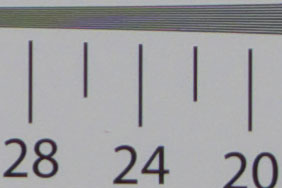 | |
2250 lpph, 5.1-12.8mm at 12.8mm, f2.8, 80 ISO |
2250 lpph, 5.1-12.8mm at 12.8mm, f2.8, 80 ISO |



